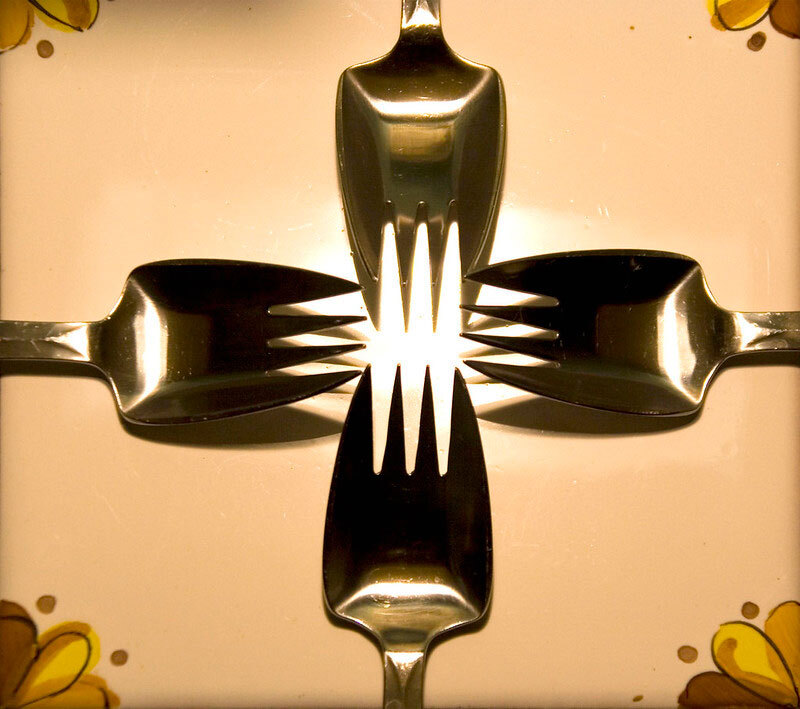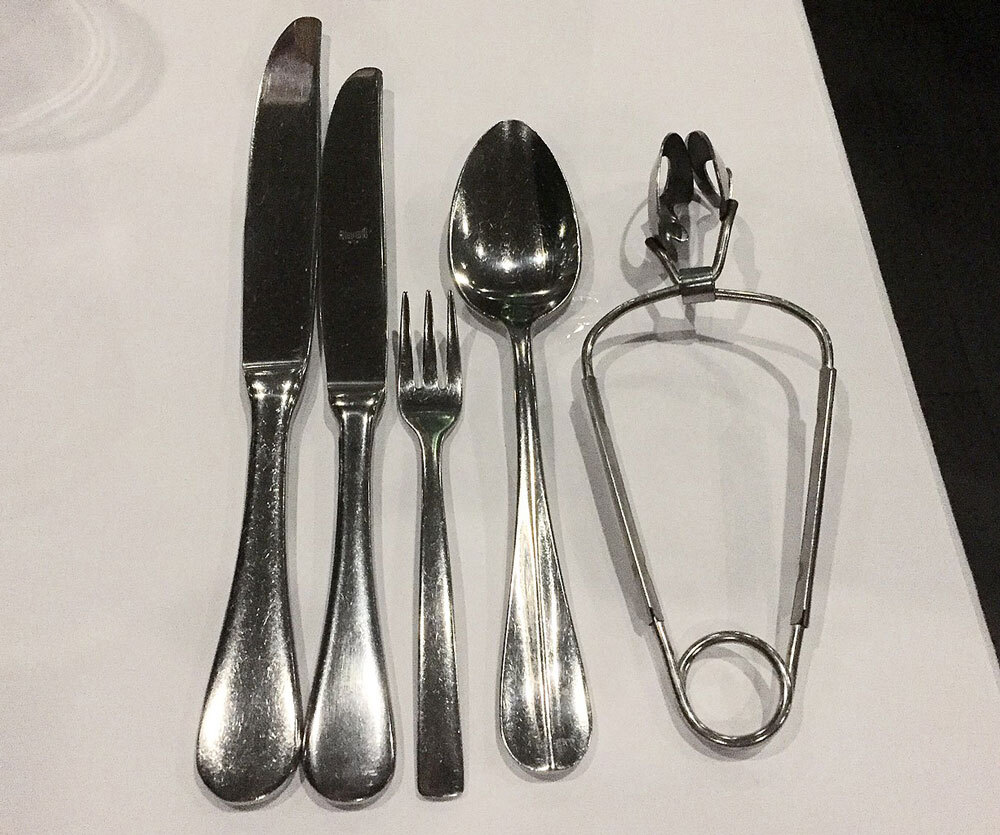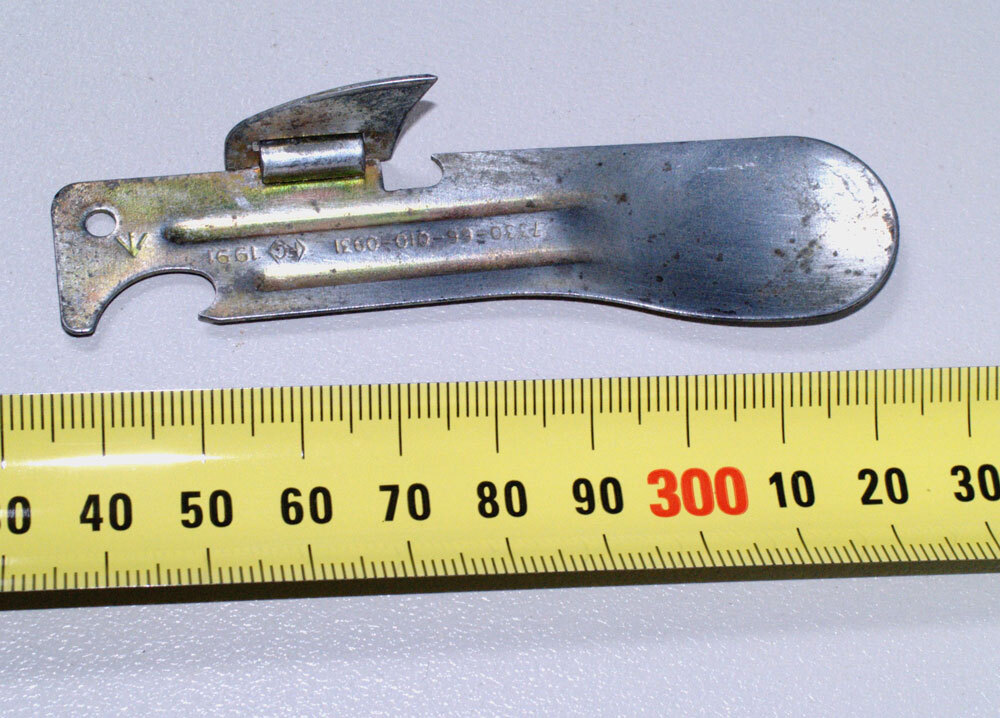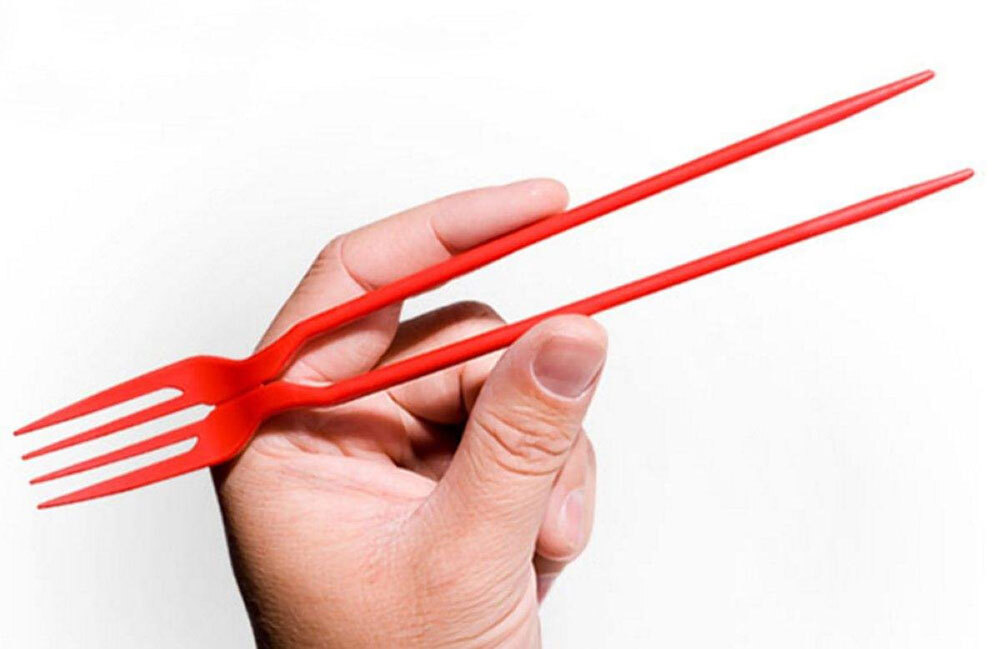Today in Tedium: If you think we’ve got a hot take on Will Smith and Chris Rock, you picked the wrong newsletter. But on the day of that unusual event, I was inspired by something that happened that I found kind of weird. See, about five hours before Smith managed to disrupt his 35-year career, I opened up a microwavable quinoa salad, and inside this packaging (from my favorite source of oddball groceries, Lidl) was a spork. But it wasn’t just any spork—it was a spork that folded in half and came with a latch, meaning that said spork was reusable. To me, I see something like this, and I clear my schedule, looking for ways to deeply analyze all the angles of this thing that I’ve discovered. This quinoa salad spork changed my life; it was like it put me in the middle of a forest with nothing but my thoughts and this spork. (And in this forest, I could only, barely, hear the sound of the slap.) After 72 straight hours of researching this spork, taking only a small series of 15-minute naps amid my research, I’m back with my report: Here are all the weird combination utensils I could find. Today’s Tedium talks alternative utensils. — Ernie @ Tedium
Today’s GIF comes from a video of a guy using a pair of egg scissors on a quail egg.
Keep Us Moving! Tedium takes a lot of time to work on and snark wise about. If you want to help us out, we have a Patreon page where you can donate. Keep the issues coming!
We accept advertising, too! Check out this page to learn more.
“When I was using a fork to cut the pizza. I realized it doesn’t really cut, I was smashing the pizza, especially the toppings and the crust—trying to cut through it didn’t really work.”
— Mike Miller, the inventor of a utensil called the Knork, a combination knife-fork setup that essentially works thanks to a beveled edge and a design the encourages a rocking motion. Essentially, according to the Lawrence Journal-World, Miller was inspired by the motion of a rocking pizza slicer being used at the pizza place at the time. Miller’s invention, which effectively balanced cutting capabilities while limiting how sharp the utensil needed to be, became one of the biggest innovations in the utensil space in quite some time.

An early ad for a Splayd. (via Newspapers.com)
Australia’s great gift to the silverware tray is a fork that’s kinda rounded like a spoon but cuts like a knife
A number of years ago, I wrote a piece about how I found it annoying that nobody had come up with a more efficient version of the umbrella, a famously bulky device that could only really be used for one purpose—to cover your head during a rainstorm.
In some ways, we’ve been dealing with this single-purpose problem for far too long with utensils. Now, to be fair, they are significantly more convenient than umbrellas because they aren’t so annoying to carry—particularly after a rainstorm, at which point it is basically impossible to put back into your bag.
Utensils, still, could use some creature comforts. Certainly, it would be better to carry one plastic device rather than three. And while the spork, the first formative patents for which started appearing in the 1870s and which gained its official name around the 1950s, certainly fits the bill in many cases, it has some limitations. For one thing, it was not really built to be a knife, though it certainly, with the right force, can effectively cut through a Mexican pizza.
There’s probably a reason why we largely see it at fast-food restaurants, where the convenience factor is paramount, and not in our kitchens, where it is generally easier to acquire an alternate device.
But the spork, as much as we find it funny to think about, doesn’t go quite far enough. A plastic soon with a couple of tines (which is what the pointy things on forks are called) may see a bit experimental, a change-up even, but others have taken this basic idea a lot further.

One person who did so is a Canadian-Australian guy named William McArthur who, in the 1940s came up with a combination spoon and fork with a boxy design and a sharp enough edge that it could be used as a knife. He called it a splayd.
This device, eventually sold commercially in Australia starting in the early 1960s, is basically a better spork, and it has been sold ever since, a shining example of what might happen when someone realizes that in most cases you only really need one utensil.
While McArthur died soon after the device was commercialized, his wife Suzanne continued to grow the business, and by the early 1970s the device, which had been patented in 52 countries, had reached the United States.
“He called them Splayds from the word ‘splay,’ which means to slant, to slope, to point outward,” she told The New York Times in 1970.
While uncommon in the U.S., it’s still commonly used in many parts of the world outside of Australia. And arguably, we should all be using them. After all, they are the opposite of an umbrella—they are the iPhones of utensils, chock-full of uses while still looking sleek and simple.

I wonder why snail tongs never took off. (Wikimedia Commons)
Five types of utensils that exist only for specific kinds of foods
- Snail tongs. If you’re into escargot, you know that snails are kind of tough to eat out of the shells, requiring the need for dedicated tongs that can properly hold the shell, allowing you to pull out the innards of the snail with a snail fork, an extremely thin device designed for an extremely specialized purpose. As the tongue-in-cheek book Miss Manners’ Guide to Excruciatingly Correct Behavior hilariously puts it: “To make the most of the dish theatrically and still have something to eat, you can buy snail plates, tongs, and forks, hide the snails in shells to give them a sporting chance, and then attack them with both hands and all this metal.” All that work for something nobody wants to eat.
- Cake forks. In a way, this is kind of like the original spork, in that it combines the functions of multiple tools into a single utensil. But the result ends up looking a bit oddball in this case, admittedly. Simply put, the cake fork (which, admittedly, can also be used for pies) has one particularly wide tine that is intended for cutting into a cake, though that use case may not be particularly obvious to end users. They might think, rather, that it’s a broken fork from the fork factory, as the cooking site Taste of Home suggests.
- Egg scissors. Too good for cracking open an egg? Egg scissors, which can separate the shell of an egg without the breaking-on-the-skillet part of the endeavor, can do the trick. But gotta admit that they look extremely strange—The full-sized version of egg scissors, referred to as an “egg topper,” appears like it was designed to remove a finger. A specific type of egg scissor exists for quail eggs, which are obviously smaller and more sensitive in nature.
- Asparagus servers. Yes, that’s correct, we live in a world where people use tongs for no other reason than to pick up pieces of asparagus. As noted by the website AC Silver, the reason for this is less functional and more as a side effect of asparagus’ novelty during the Victorian era, when the vegetable was considered an exotic food.
- “Trongs.” If you’re a wussy fan of eating chicken wings or ribs, you might find these tiny plastic claws to be a helpful strategy for helping to keep your fingers clean while still enjoying finger food.

This can opener has the slightest faint of a spoon attached. (Wikimedia Commons)
Australia’s less-great gift to the silverware tray is a spoon mixed with a can opener that doesn’t do either job particularly well
The same year that William McArthur was first trying his hand at building the splayd, Australia gave us another unusual kind of utensil, and this one wasn’t quite so much one to write home about—even if the people who used it likely were in fact writing home.
But I guess war makes for unusual needs. Because it was certainly the reason hundreds of thousands of Australians were introduced to FRED.
The field ration eating device, or FRED, has a somewhat friendly name, but the device itself is not exactly a friendly utensil. Its spoon is basically a minor divot at the bottom of the utensil. It has a bottle opener, but its real benefit is that it has a fold-out knife on the side sharp enough to cut through a can, which is sort of the real purpose of the device. Not exactly a Swiss Army Knife, but definitely more versatile than a spoon on its own.
While the device is Australian, it does borrow some direct inspiration from the United States. In 1942, the U.S. Army first distributed the P-38 can opener, a handheld device that allowed soldiers to easily break into whatever cans they needed to open. (The P-38, too, gained a cult following among soldiers.) FRED, released the next year in Australia’s CR1M ration packages, combines the P-38 with a spoon and a bottle opener.
Despite its checkered reputation as a tool of last resort, it had its defenders, in part due to their lightweight size, making them a convenient carry. In a 2005 letter to the editor to Army: The Soldier’s Newspaper amid rumors that FRED was getting retired in favor of plastic utensils, Capt. Brian Tuohy wrote a passionate defense of the device, despite the fact that its primary utensil, a spoon, seems to be more of a suggestion of a spoon than an actual spoon.
“The American, Canadian, Chinese and Japanese defense forces have tried to emulate the functionality of Fred but have never been able to copy its unassuming construct,” he wrote. “Ration pack tinned cheese will never be the same and, I might add, how can one eat ration pack cheese with a plastic spoon? It’s sacrilege.”
Maj. Justin Bayley, who was in charge of foodstuff logistics for the military at the time, defended the decision as a way to improve the overall quality of field rations.
“In all seriousness, this change is being implemented so that the money that is saved can be used for new items that will benefit all consumers of ration packs,” Bayley wrote in response. “Just like the new spoon we have selected that is cheaper than the old one, the money we save on one item will be used to pay for new and better items.”
Now, to be clear, FRED was not like this adored utensil or anything—it was basically a device that soldiers gained affinity to because they had to use it. (Its nickname, the “F-----g Ridiculous Eating Device,” spoke to this point. After all, you could barely call its divot a spoon.) But in a lot of ways, that focus on utility likely gives the device its appeal.
Obviously, the nature of this discussion is a bit oddball, and I think a big part of that is that, at least in the Western world, we’ve basically decided upon a handful of major utensils that simply work. We’ve committed to the knife, spoon, and fork for most tasks.
But honestly, why do we have to be limited to these specific tools? Is there something out there that would work better? Why aren’t we all using splayds, given the fact that they effectively solved the bulk of the problems we have with forks and spoons decades ago?

Might as well combine ’em. (via Amazon)
Certainly attempts are out there. If you look hard enough, you can find lots of examples of hybrid chopstick/fork/knife devices that make it possible to switch approaches mid-meal, if you’re feeling like you need to get creative about how you eat your General Tso’s. We live in a world where something called The Chork exists, and here we are trying to convince ourselves that forks are the best ways to eat. (And it’s not the only one!)
Other cultures have gotten plenty creative with different ways of eating food—for example, injera, a longtime staple of Ethiopian cuisine, is a type of fermented flatbread that doubles as a napkin and utensil all the same.
But in terms of knives and forks, there’s still some questions about arbitrary limitations. Who’s to say that we have to limit ourselves to devices made of metal and plastic?
Certainly the plastic silverware raises significant long-term issues. Disposable silverware is often built using wasteful means and every single knife, fork, and folding spork, in its own small way, adds to the piles of plastic that are basically filling up landfills the world over. (Which, honestly, makes a compelling case to bring back FRED, which can be more easily recycled than most plastic spoons thanks to the fact it’s made of steel.)
And that means that the next generation of unusual utensils are likely to be built with environmental factors in mind. Case in point is the Ecotensil, a spoon-like device that is basically just a cleverly-folded piece of card paper that can be used as a spoon. It essentially exists to ensure that my quinoa salad can exist without needing a folding spork at all.
The advantages of this approach are obvious—the paper is far more likely to quickly biodegrade, and since it’s paper, it takes up far less shipping space than even the most compact fork ever could.
Of course, there is also a case to simply encourage people to eat the utensil instead of biodegrade it, a concept that has been pitched by a few companies, including the firm Incredible Eats, whose ready-to-eat spoons appeared on Shark Tank a few months back and drew a rare feeding frenzy where, at one point, the startup had four separate offers on the table:
To me, that suggests that there’s probably room for some disruption in the utensil space, if someone is willing to stick a fork into it.
--
Find this one an interesting read? Share it with a pal!





